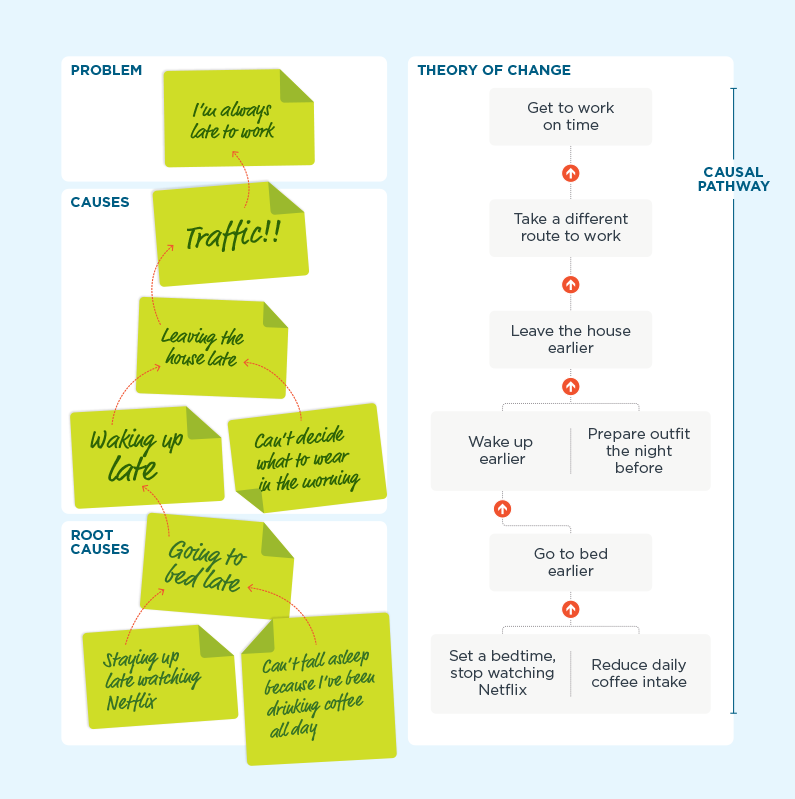
Theory of Change: It’s Easier Than You Think
March 13, 2018 | 4 Minute ReadExpert Kasia Kedzia debunks two common myths about theory of change and explains a simple exercise that makes creating a theory of change a breeze.
Imagine you are chronically late to work. If your goal is to get to work on time, you may have identified multiple reasons for being late. If you only consider one of these reasons and don’t identify root causes, which are simply other reasons for your lateness, you will continue to be late. One reason may be traffic, but another may be leaving your house late, or not getting to bed on time.
Similarly, in the development work we do, if our solutions don’t match the root causes of the problems, our work will fail to make a difference and the consequences can be staggering. Creating and applying theories of change (ToCs) can help us be more thoughtful, deliberate, and effective in our interventions. However, there are two major misconceptions that keep us from systematically and continually applying theory of change to our work.
Theories of Change Are Too Complex
Theories of change are actually simpler than you think.
The ToC is just a road map. It’s the articulation of how and why a given set of interventions will lead to specific change. It follows a generally straightforward “if/then” logic — if the intervention occurs successfully then it will lead to the desired result. Of course, behind that logic is a set of beliefs and assumptions that support our expectations about how change will occur.
Here is a simple activity to create a theory of change. Take out a few sticky notes and have your team jot down the major problem and the contributing problems as separate statements, each on their own sticky note. Order them following the “if/then” logic. Write down corresponding solutions on separate sticky notes and order them in the same fashion. If each team member does the exercise separately, you can come together and check your logic. Does each members’ order correspond with yours? Or does the order of your solution statements not match your problem statements? If the answer to these questions is no, it can be a red flag to reexamine your logic.
The reason why ordering the sticky notes can be so important is that it can expose your assumptions. We assume that each of us would follow the same causal logic to get to a given solution, but that’s not a given. Articulating our theory and stating our assumptions out loud can go a long way to helping flesh out our path.
The development problems we grapple with are complex and can lead to complex theories of change that exacerbate the myth that theories of change difficult to understand. Yet, the purpose of a ToC is to get at and articulate the most important steps for the greatest level of impact, so ideally it should be simple. Historically, USAID began the practice of drafting and passing on a theory of change in response to turnover at USAID missions around the world. It was an attempt to ensure that the approach didn’t change with every changing of the guard. The simpler and easier it is to follow a ToC, the easier it is for others to carry on the work, monitor progress against the ToC, and adjust accordingly.
2. Theories of Change Are a “Nice to Have,” Not a “Must Have”
In addition to being simpler than you think, ToCs are also more important than you might realize. When you run through your causal logic, you can get to the root of the problem and identify corresponding solutions for each problem. When you order your problem statements, you form your theory. You can than follow the pattern by also ordering the corresponding solutions.

In the causal path above, if some of the root problems were not identified, such as staying up late watching Netflix or not being able to fall asleep due to coffee habit, it would be easy to jump to the possible wrong solution. If we stop at traffic or waking up late and assume that is our cause, our potential solution won’t result in getting to work any faster. The path above is also very different from this second causal path, demonstrating that two individuals often approach the same problem differently but may not realize it until mapping out their assumptions through a ToC.
Making similar mistakes on a development program can lead to much worse consequences. Even taking a few moments to stop and articulate our assumptions and some very straightforward causal logic can help shift our approaches. When we have a good ToC in place that is plausible, feasible, and testable, we are better able to not only articulate what we think success will look like but how we will know if we are on track over time. We will have a theory around what the project is “supposed to look like,” a strategy to accomplish it, and a plan to know if our intervention is working as the project goes on.
A Simple Yet Effective Tool
When mapping out a theory of change, we can walk someone through what project success looks like, how it’s supposed to work, the strategy we are taking to accomplish our goal, what we want to learn, and how we will know if it’s working. Contrary to popular belief, the point is to keep the ToC simple. Above all, when we apply it we may be preventing some major potential pitfalls from the start. At most, we will have greater impact through our work. At the least, we will get to work on time.

















